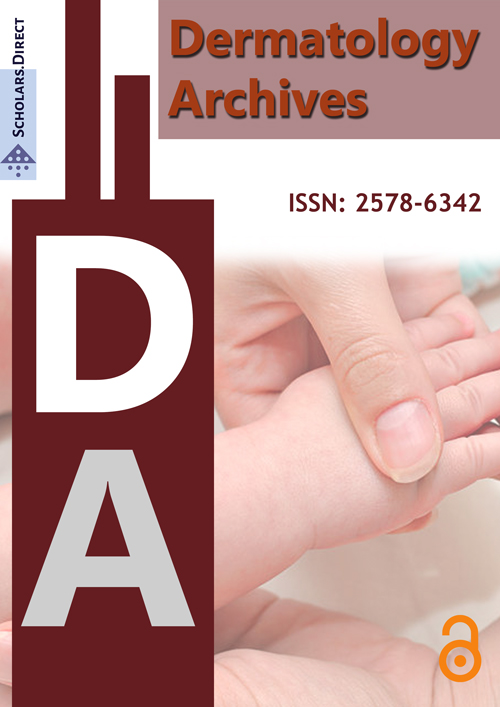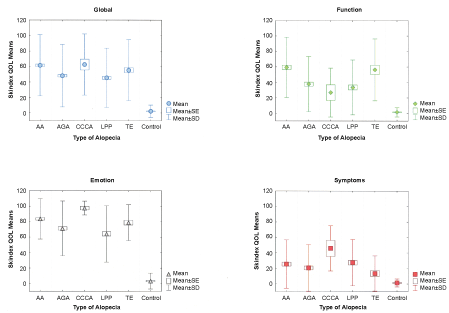Quality of Life in Women with Alopecia
Hair loss is a psychologically devastating disorder, causing grave distress to patients of all ages, genders, and nationalities. Due to the visible nature of hair loss, individuals become increasingly self-conscious, and over time may develop anxiety or depression [1]. Furthermore, the psychological stress related to alopecia can impair functioning in social and professional arenas, affecting relationships and creating work related problems [1]. Despite the available treatments for alopecia, their efficacy is not well established and following disease course and treatment success relies on patient perception [2]. Quality of life (QoL) studies are a valuable tool in assessing patient well-being, coping mechanisms, and disease burden on patients' activities of daily living, as well as effects of therapy [2,3].
Previous studies examining alopecia QoL focused on non-scarring conditions such as alopecia areata (AA), telogen effluvium (TE), and androgenetic alopecia (AGA) [1-3]. QoL in cicatricial alopecia is rarely examined, and there has been no comparison with impact of non-scarring alopecias [4]. Our study objective was to determine the impact of hair loss and provided therapies on QoL in patients with scarring (central centrifugal cicatricial alopecia (CCCA), lichen planopilaris (LPP)) and non-scarring alopecia (AA, AGA, and TE).
This study was approved by the research ethics board at Cleveland Clinic and conducted in the Cleveland Clinic Department of Dermatology in Cleveland Ohio. Eligibility criteria included a diagnosis of CCCA, LPP, AA, AGA or TE, age above 18 years, and female gender. Over a 20-month period, 1000 patients seen for hair loss met eligibility criteria. Instructional letters for completing the anonymous online survey were mailed to all eligible patients, and 114 completed the survey. For comparison, a control group of 100 individuals without alopecia were invited to complete the online survey, with 20 individuals participating. QoL data were collected using RED Cap (Research Electronic Data Capture) Survey, a secure, web-based system used to support data collection for clinical studies [5]. QoL was assessed using Skindex-16, modified to address alopecic disorders, with two additional questions to assess hair loss over the previous month [3].
The data were analyzed using ANOVA. Tukey-Kramer adjustments were used to correct for multiple means pairwise comparisons. Populations were grouped based on the presence or absence of alopecia, non-scarring or scarring type, patient age categories (18-30, 31-45, 46-60, and > 60), and the presence or absence of treatment. Each of the patient population groupings were tested for differences in scores for emotions, function, symptoms, and global domains.
The most common alopecia subtypes were AGA (34%) followed by AA (33%). Of the cicatricial alopecia subtypes, 23% of patients had LPP compared to 2% with CCCA. Most respondents identified as Caucasian (85%) and were between the ages of 46 and 65 (61%). At the time of survey, 83% of respondents were being treated for alopecia.
Patients with alopecia had significant QoL impairment compared to controls (p < 0.002, Table 1), and those with scarring alopecia experienced worse QoL impairment compared to non-scarring alopecia, except where symptoms are concerned. No significant differences were found in the QoL scores between patients who were receiving therapy and those who were not. Pairwise comparison demonstrated higher scores in the emotions domain between patients aged 31-45 and 46-65 when compared to patients who are 65 and older (p < 0.001 and p = 0.018, respectively). Differences among QoL domains by alopecia subtype are presented in Figure 1.
Our findings demonstrate that hair loss patients have a lower quality of life in the emotional and functional QoL parameters. Usage of Skindex-16 allows us to compare QoL of patients with alopecia and other skin disorders. In comparison with alopecia, atopic and contact dermatitis showed similar global scores, while vitiligo had lower scores [6,7]. In fact, functioning and emotional aspects were worse among alopecia patients than those with non-melanoma skin cancers [8].
Our results allowed us to gain insight into the substantial QoL burden of scarring alopecia, as these patients exhibited extensive QoL impairment in the emotions, functions, and global domains. This is possibly associated with the irreversible nature of the condition and lack of effective treatment options. In addition, prior studies have found that patients often feel greater QoL impairment than could be predicted by their symptoms, and a disconnect between patient and physician perception of hair loss [4].
The findings from this study substantiate the broad scope of effects that hair loss causes in the lives of women. Physicians who encounter patients with alopecia should consider the impact of hair loss on QoL during original assessment and follow-up [2]. Larger QoL studies, with better response rates are needed to further address the impact of hair loss.
Acknowledgements
We would like to thank Dr. Mary-Margaret Chren for allowing the use and modification of Skindex-16 for completion of this study.
References
- Hunt N, McHale S (2005) The psychological impact of alopecia. BMJ 331: 951-953.
- Schmidt S, Fischer TW, Chren MM, et al. (2001) Strategies of coping and quality of life in women with alopecia. Br J Dermatol 144: 1038-1043.
- Chren MM, Lasck RJ, Quinn LM, et al. (1996) Skindex, a quality of life measure for patients with skin disease: reliability, validity, and responsiveness. J Invest Dermatol 107: 707-713.
- Chiang YZ, Bundy C, Griffiths CE, et al. (2015) The role of beliefs: lessons from a pilot study on illness perception, psychological distress and quality of life in patients with primary cicatricial alopecia. Br J Dermatol 172: 130-137.
- Harris P, Taylor R, Thielke R, et al. (2009) Research electronic data capture (REDcap)- a metadata-driven methodology and workflow process for providing translational research informatics support. J Biomed Inform 42: 377-381.
- Krishna GS, Ramam M, Mehta M, et al. (2013) Vitiligo impact scale: an instrument to assess the psychosocial burden of vitiligo. Indian J Dermatol Venerol Leprol 79: 205-210.
- Benyamini Y, Goner-Shilo D, Lazarov A (2012) Illness perception and quality of life in patients with contact dermatitis. Contact Dermatitis 67: 193-199.
- Chen T, Bertenthal D, Sahay A, et al. (2007) Predictors of skin-related quality of life after treatment of cutaneous basal cell carcinoma and squamous cell carcinoma. Arch Dermatol 143: 1386-1392.
Corresponding Author
Danyelle Dawes, MD, Department of Dermatology, University Hospitals Cleveland Medical Center, 11100 Euclid Avenue, Cleveland, Ohio 44106, USA, Tel: 216-844-5794, Fax: 216-844-8993.
Copyright
© 2018 Dawes D. This is an open-access article distributed under the terms of the Creative Commons Attribution License, which permits unrestricted use, distribution, and reproduction in any medium, provided the original author and source are credited.





